By Sally Siko



By Sally Siko
Check out these little guys, a Hairy Woodpecker and a Downy Woodpecker
I spotted both species while birding here in central North Carolina.
At first glance, Hairy Woodpeckers (pic 1) look nearly identical to a Downy (pic 2) yet are a few differences that can help you figure out what you’re looking at.


The first big clue is size.
Hairy Woodpeckers are around 9 inches long and weigh 3x as much as the Downy making them noticeably larger in size when comparing the two.
The second clue is that the Hairy Woodpeckers bill is as long as it’s slightly elongated head vs. the Downy who’s got a comparatively shorter bill size paired with a rounder head.
The third clue is habitat. Although the range and habitat preferences of the Hairy Woodpecker generally overlap that of the Downy, the Hairy is a slightly shyer bird which spends more of it’s time in the deep woods vs. our backyards. That being said, they may be enticed to visit your feeders if you offer up suet during the winter months.
Measuring a diminutive 6 inches in size, Downy Woodpeckers (pic 2) are North America’s smallest species of Woodpecker.
These feisty little ones are found throughout most of North America with a range that stretches all the way from Alaska down to Florida.
It lives in a variety of habitats from deep wilderness hardwood forests to suburban backyards and city parks.
Here in the Tarheel State, Downys are also a familiar year round visitor to our bird feeders which is why they occasionally may be mistaken for their larger cousin, the Hairy Woodpecker.
Whichever of these sweet little black and white feathered gems may be, it’s always a treat for me to see them racing up and down the tree trunks in search of a meal.
Aren’t they gorgeous?
Photos by @sally_siko of @bestlife_birding on my mighty mirrorless monster, the @canonusa #R5
By Sally Siko
While birding yesterday morning along the Neuse River, I spied a pair of Brown Thrashers building a nest in a low shrub right next to the trail.
I sat down for a few minutes and watched them gather twigs from the ground and then place the sticks carefully into the new nest.
They both went about this endeavor thoughtfully, arranging and then rearranging the tangle of twigs and grass several times, sometimes squatting and spinning around to press the sides of the nest together juuuuuust right.

One thing that I noticed about this encounter was the fact that the pair was completely silent. No chirps were exchanged between the pair as they moved through the woods.
This makes sense though because they were trying to be sneaky as building a nest requires a bit of discretion on their part.
Nest construction aside, these birds are usually quite noisy as they go about the business of finding their next meal. Often sticking to dense undergrowth, the sounds of scraping of dry leaves and their loud whirring chirps are a distinctive clue that one is nearby.
Primarily a ground foraging species of bird, Using their long, slightly curved bill as a rake, they’ll sweep the leaf litter around to uncover delicacies such as insects, fallen seeds, and berries.



Brown Thrashers are talented mimics too, nearly as talented as their close relative, the Northern Mockingbird.
They boast a wide repertoire of songs which they’ll belt out from the top of the highest tree in the neighborhood letting every other bird know who’s turf they’re on.
Look and listen for these handsome birds throughout the year in the Carolinas in suburban neighborhoods and in areas of deciduous forests that line open fields.
Aren’t they lovely?
Photos by @sally_siko of @bestlife_birding on my mighty mirrorless monster, the @canonusa #R5
By Sally Siko
One of my favorite early spring arrivals is the Yellow-throated Warbler. With that bold yellow, black and white plumage, they’re absolutely captivating to photograph.
I found this handsome fella this morning while birding along the Neuse River Trail Capital Area Greenway in Raleigh.
Happily he was hopping and flying at a lower level of the tree canopy so that I could get a good view.
Normally they tend to hang out much higher in the trees so it was neat to get a close up look at him!

This species of wood warbler are one of a handful which nests exclusively in the eastern part of the United States with a range that stretches from Missouri in Pennsylvania all the way down to Florida and into the Gulf of Mexico.
Their open cup-nests are constructed almost entirely by the female from bark strips, grasses, and weed stems, and lined with plant down and feathers. The nest is usually placed in the canopy of a pine, cypress or sycamore tree on the end of a a horizontal branch well out from the trunk at heights ranging from 15 to 60 feet above the ground.







Happily these gorgeous birds will spend the summer raising their families here in the Tarheel state. They will stick around until late September (or even into early October in our eastern counties) so there is still plenty of time for us to enjoy them this year.
Btw, if you’d like to see a Yellow-throated Warbler too (along with many other beautiful birds!) I invite you to check out the link below to view all of my upcoming group birding tours.
I’m leading trips to destinations ranging from South Carolina to Maine.
Join me in discovering why there’s a lot to love about the East Coast of the United States when it comes to bird watching.
See ya out there!
Photos by @sally_siko of @bestlife_birding on my mighty mirrorless monster, the @canonusa #R5


By Sally Siko
Pleased to see that the pair of Baltimore Orioles are still visiting the feeder! They’d shown up this past December and haven’t left. I’m hoping they’ll just choose to stay here in Lillington NC and perhaps build a nest somewhere in the yard.
We will see 🙂

As shown here, male Baltimore Orioles are known for their vibrant orange and black plumage, which resembles the colors of the coat of arms of Lord Baltimore, hence their name.
They are also are renowned for their melodious and flute-like songs, which they use to attract mates and defend their territories. Their songs are often heard echoing through woodlands during the breeding season which begins in early May.
These birds are masters of nest construction, often weaving intricate hanging nests from plant fibers, grasses, and other materials. Their nests are commonly found hanging from the outer tips of tree branches anywhere from 30ft to 80ft up in the canopy.
While they are commonly associated with the northeastern United States, Baltimore Orioles can be found across much of North America during the breeding season, ranging from the eastern and central parts of the continent to parts of the southwestern United States and even into Canada.

Baltimore Orioles typically begin their southward migration from North Carolina in late summer or early fall.
Some (like this guy here) end up spending the winter in the Tarheel State.
Depending on various factors such as weather conditions and food availability, their migration can start as early as August and extend through September. By October, most Baltimore Orioles will have departed from North Carolina on their journey to their wintering grounds in Central and South America.
That’s a good thing because this means you’ve got plenty of time to see one before the year is through!
Photo by @sally_siko of @bestlife_birding on my mighty mirrorless monster, the @canonusa #R5
By Sally Siko
With as much traveling as I do throughout the year chasing birds, I’ll be the first to admit that I haven’t given much attention to my feathered friends right here at home.
That changed in February when Michael offered to build me a bird and pollinator friendly yard.
Now I’d originally envisioned something low key.
Perhaps an 10×4 ft long strip of wildflowers and fruiting shrubs with a row of bird feeders skirting the row.
No big deal, just a pretty strip of flowers and feeders set off to the side of my backyard.
The thing is that my better half had a far better vision for the space!
This isn’t surprising given Mike’s extensive background in landscaping and his passion for gardening, yet I was blown away with the final results as this project far surpassed my expectations.
Here’s how we set off with this transformation from ho-hum boring grassy lawn to a beautiful backyard bird oasis!
Here is what the yard looked like before we started the work.


The first order of business was to remove the sod from about a third of my backyard to prep for planting.
We rented a sod cutter from Home Depot and got to work clearing three sections of the yard.
Two areas would be for planting flowers, trees and shrubs, the third will be a dedicated vegetable garden.
If you’ve never cut sod from the yard before I highly recommend that you buy or rent the most powerful machine you can afford. The idea is you want the cutter to work quickly and efficiently.
Another tip is to make sure that you have help moving the sod squares out of the cut area as they can be quite heavy to carry after pushing the sod cutter all day. I’m so grateful that Michael and my son were there to get this part done.
The adage “more hands make less work” applies here for sure lol!









Next up was tilling.
Again, don’t skimp on the price of a rental if you can afford to do so as the more powerful machines will get the job done in half the time.
Here’s a good tip: you can save money by purchasing a used high quality tiller.
Use it to complete the job, clean it off and then sell it after your done. We did that and actually made an additional $50 on the resale after the fact lol!










I also recommend that you cut the sod and till the dirt on days where the soil is dry. It’s much harder to carry the sod when it’s wet and tilling muddy dirt on a rainy day isn’t the most fun lol!
In addition, watch out for grubs and worms which will pop out from the freshly turned soil.


I picked up about a dozen grubs and put them on the top of my fence which the Bluebirds gobbled up immediately. A couple of happy Yellow-rumped Warblers found snacks hidden in the freshly turned dirt which was pretty cool too.
Mike also found a sleepy Bumblebee snoozing in the dirt which he carefully picked up and set free so that it wouldn’t get injured by the tiller.



Next it was time to build a pergola.
This was 100% Michael’s idea.
I’d told him that the yard was his blank canvas so whatever he thought would look cool while serving a greater purpose would be fine with me.
As it turned out this was a good move because now we’ve got a place to hang several bird feeders and a nice place to sit and enjoy the birds under the cover of semi-shade.
The pergola took about 3 days for Mike to build including construction and staining.
No formal plans were drawn out.
Just straight out of his brain into my yard, lol! It was neat to see how the structure came together in such a short time built with nothing more than scrap wood, concrete, wood stain and willpower.




Now it was time for the fun stuff, adding plants!
Although I absolutely adore my Hostas, Hydrangeas, Daffodils, Irises and Lillys, I really want this space to eventually be 90% filled with plants native to North Carolina.
I also didn’t want to have to spend a tremendous amount of money to fill the garden so I turned to Facebook marketplace to see if I could score a deal or two on some new plants.
As luck would have it, we ended up finding some nice native Blueberry and Elderberry bushes which we purchased from private individuals here in the Triangle.
I also scavenged a few raspberry and blackberry bushes from the woods behind my house and transplanted them into the yard too.
I’m really looking forward to seeing how happy the birds are going to be once these bushes start yielding fruit!


We also planted a ton of mixed wildflower seeds, scattering them by the handfuls throughout the garden.
I’d tell you what species they were but unfortunately I fucked up and threw away the seed packets and have forgotten exactly what all was in there lol!
It’s gonna be an incredible sight watching that array of color bloom in the backyard this summer.
Hopefully once the flowers come out, I’ll be able to identify them then.
In addition I thought it would be cool to see sunflowers outside my bedroom window so Mike cut out an additional bed and planted a ton of sunflowers and Zinnias too. I’m sure the neighborhood flock of Goldfinches are going to be stoked once those flowers go to seed.
Finally, it was time to plant a couple trees.
I’d already purchased a Peach tree a few years ago. Unfortunately I had planted it in a dumb spot too close to my fence (rookie mistake lol) so Mike dug it up and transferred it to a better spot in the new garden where it would have plenty of space to grow.
Next up was the Dogwood which had already been growing near the back corner of my yard. Again, Michael and I dug it up and transplanted into a better spot in the garden where it would thrive.
I’m hoping that the berries from this tree will provide the Cardinals in my neighborhood with plenty of nutritious food later this year.
Mike also picked up a beautiful little Apple tree which yielded a gorgeous cluster of blossoms shortly after planting it. The bees absolutely loved diving in and out of those flowers which was freak’n awesome!





With new plants in the ground now things were really starting to get exciting!
Still there was more to do.
Up next, mulch…
So.
Much.
Mulch.
10 yards to be exact.
160 wheelbarrow fulls.
Thank goodness the temperatures were in the 50s that day or we might have died from heat exhaustion haha!
Shoveling, pitching and spreading.
2 people, 6 hours = super tired but incredible results!








That mulch looked awesome. I love how the black contrasts with the green plants!











Now came some finishing touches.
Mike had some extra scrap wood left over from the pergola construction.
Not wanting anything to go to waste, he spent a couple hours and built a bench and a small patio at the back fence.
It’s a simple design with clean lines and set right at the perfect height for someone to sit and hold a camera comfortably.

To help make the birds feel at home Mike also built a couple of bird houses and installed them on top of the fence.
He also picked up a few cedar versions from WalMart that were only $12 a piece so that was a great deal!
It only took about a week before a family of Eastern Bluebirds and Carolina Chickadees took over to the nest boxes.
I’m so excited to see the sweet little birds raise their families later this spring!

We then picked up some pavers from Lowes and started lining the sunflower bed. As of the time I’m writing this post, we still have plans to line all the flower beds with these beautiful pavers which look like natural stone.
Hopefully we’ll get that done within a couple of weeks!




One of my favorite elements of the new garden area are these cool looking solar lights. They are pretty bright for a solar set up and really set off the design of the garden at night!
We’re thinking of adding some additional lighting on the back fence line to give the space more depth but still need to decide what kind of lights would look best.
I’ll keep ya updated 🙂



Lastly… the pond.
Errr what will be a pond lol!
I’ve got an idea to build up some dirt at the front end of the garden and install a waterfall trickling down into a creek which empties into a small pond at its base. The thought is that it will attract more birds into the yard to drink and have a bath. Plus, I really like the idea of listening to running water while sitting on my porch in the evening.
There is an offside chance that I might include some fish in the pond, perhaps catfish or goldfish. We’ve got a number of Great blue Herons in the area so I don’t imagine they would last very long, but it might be worth a try.

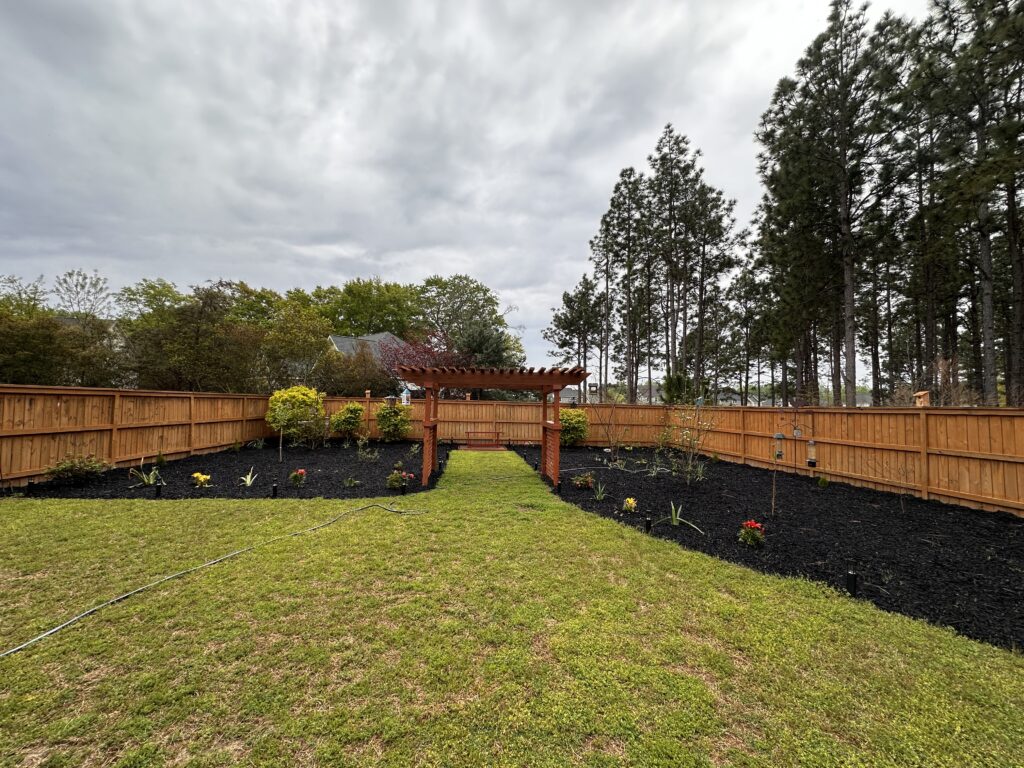
So there ya have it. This project took one month exactly to complete (February 28 to March 28th).
So far my backyard bird species count is up to 62 species and I can’t wait to see what new birds show up later this year.
Bird seed and suet was purchased at Tractor Supply Co. in Fuquay Varina, NC. It’s my go-to place to feed all my feathered friends! So far the favorite blend with my backyard birds is the fruit and nut blend and the warblers really love the berry flavored suet. Order some for your flock at the product links below!
Fruit & Nut Mix Wild Bird Food
Royal Wing Berry Flavored Suet
I’ve had backyard gardens in the past, but nothing like this. I’m still blown away by the transformation in the yard and could not be more grateful for Michael’s help.
It’s been hard work getting all this together in such a short time, but absolutely worth it!






















By Sally Siko
I’m looking forward to later this spring when I’ll visit western NC to go photograph turkeys again.
They are so entertaining to watch as the Toms strut their stuff during the breeding season!
A year round resident, the Eastern wild Turkey is found in nearly every county here in North Carolina. As a flock, they’re skittish birds which in my experience, are best photographed from belly down in the grass perspective as not to spook them off.
These guys are constantly on the move, always on the lookout for a new snack (nuts, seeds, grains, insects and small fruits) to gobble down.
They’re most frequently observed foraging in the early morning hours around sunrise, and will also feed actively in the evening before darkness sets in.

Turkeys are interesting birds.
Did you know that Wild Turkeys are ground nesters and will lay around a dozen eggs per clutch?
That’s a lot of eggs and the hen doesn’t lay them all at once. Instead she’ll lay one egg per day but will not begin incubating them all until the last egg is laid.
Although the first laid eggs will get cold (exposed to the elements) during the first few weeks, the fascinating thing is that the embryos in the eggs will not start to develop until the hen starts warming her clutch by sitting on the nest after all the eggs have been laid.
This ensures that even though there was a two week difference between the first egg & last egg being laid, the entire clutch will hatch at the same time!




The Eastern Wild Turkey is a year round resident of North Carolina. They are found in all 100 of our counties and unlike other species of birds, thanks to conservation efforts (and the decline of large predators) their population is actually on the increase!
Look for them in open, tree lined fields in the morning and evenings throughout the Tarheel state.
Photos by @sally_siko of @bestlife_birding on my mighty mirrorless monster, the @canonusa #R5
By Sally Siko
eBird is a popular citizen science project developed by the Cornell Lab of Ornithology and the National Audubon Society. It allows birdwatchers and nature enthusiasts to record their bird sightings, contribute to scientific research, and explore birding hotspots worldwide. Here’s a step-by-step guide on how to use the eBird app to make the most of your birdwatching experience:

Step 1: Download and Install the eBird App

– Visit the App Store (for iOS devices) or Google Play Store (for Android devices).
– Search for “eBird” and download the app developed by the Cornell Lab of Ornithology.
– Install the app on your device.
Step 2: Create an Account
– Open the eBird app on your device.
– Tap on “Sign Up” or “Create Account” to register for a new account.
– Follow the on-screen prompts to enter your email address, create a password, and provide some basic information about yourself.
– Once you’ve completed the registration process, log in to your newly created eBird account.
Step 3: Explore Birding Hotspots

– Upon logging in, click on the magnifying glass icon at the bottom of the screen to bring up a map displaying birding hotspots in your area.
– Use the search bar to find specific locations or browse through the map to discover nearby birding sites.
– Tap on a hotspot to view more information, including recent sightings, species lists, and comments from other birders.
Step 4: Report Your Bird Sightings
– To report a bird sighting, tap on the “Submit” button located at the bottom of the screen.

– Select the date and location of your birding outing using the calendar and map interface.
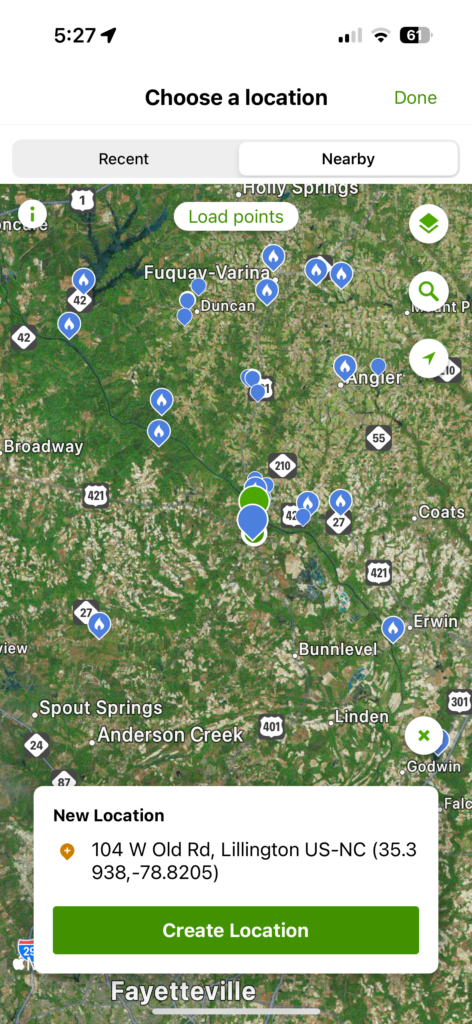
– Enter the species you observed by typing the name or using the app’s built-in bird identification tool.
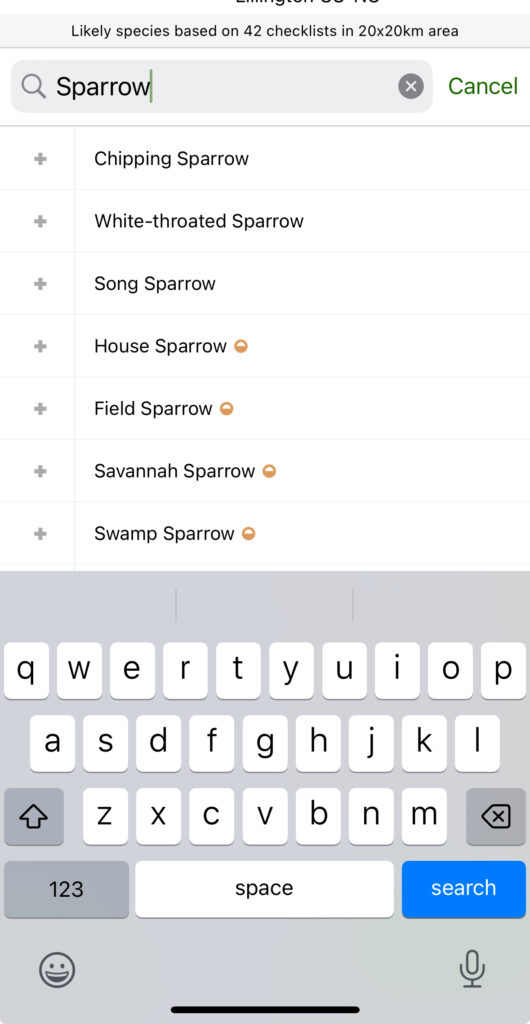
– Indicate the number of individuals observed and any additional comments or observations.
– Rare & previously unreported birds (indicated by red dot shown next to the bird’s name) will require checklist comments with species observations. Use descriptions like plumage color, behavior, size and song type.
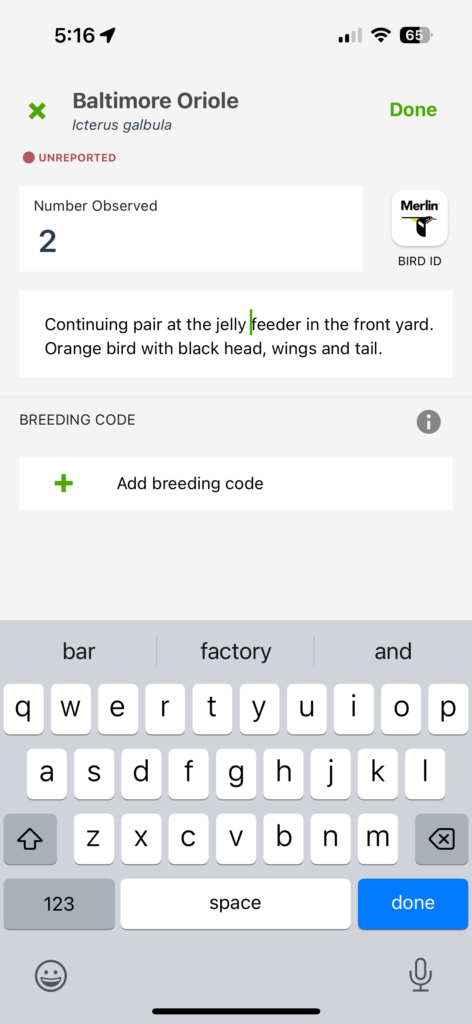
– Review your checklist and tap “Submit” to upload your sighting to eBird’s database.

Step 5: Explore Your Personal Data
– Navigate to the “My eBird” section of the app to access your personal birding data.
– View your lifetime, year, month, or day lists to track your birding progress over time.
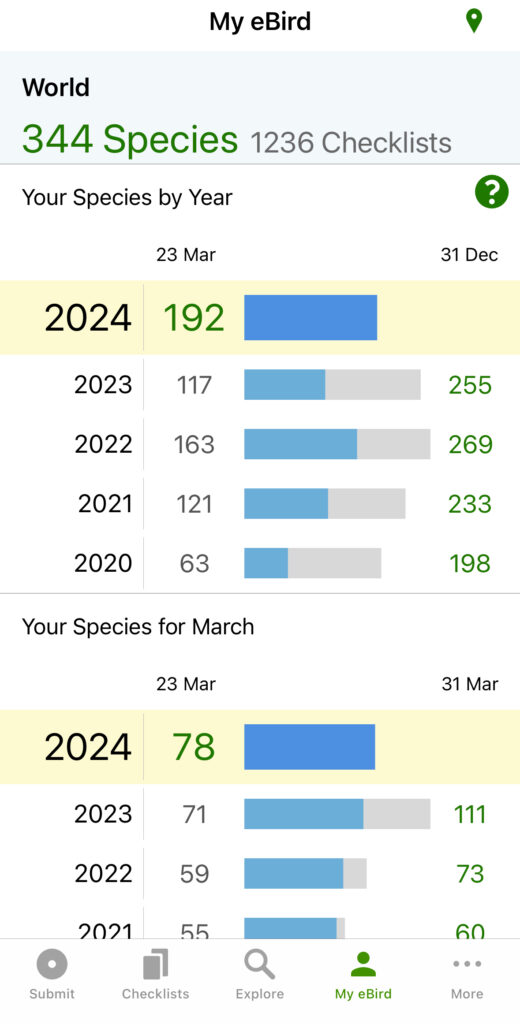
– Explore your personal statistics, including the number of species observed and your birding activity by location.
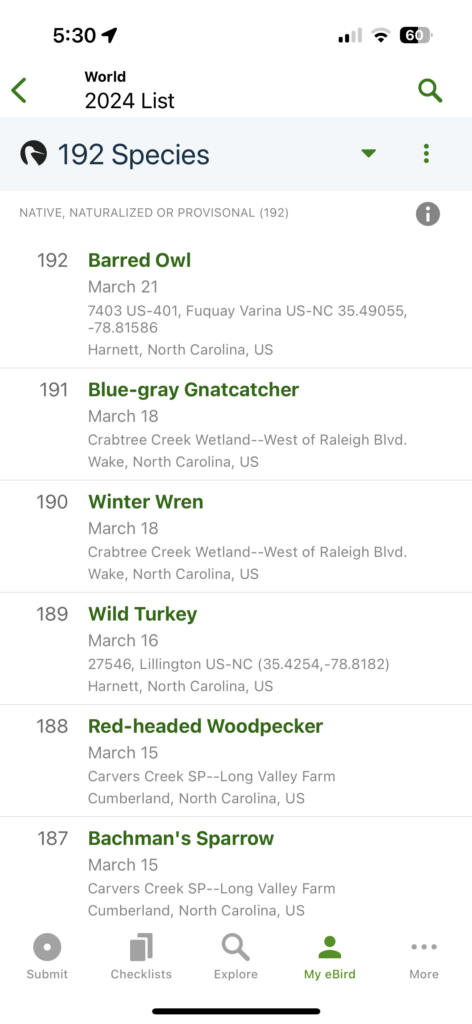
Step 6: Contribute to Science
– By reporting your bird sightings to eBird, you’re contributing valuable data to scientific research and conservation efforts.
– Your observations help researchers better understand bird populations, distributions, and migration patterns.
– Participate in eBird challenges and special projects to further contribute to ornithological science.
Step 7: Customize Your Settings
– Click on the three little dots in the bottom righthand corner of the screen to explore the app’s settings to customize your eBird experience.
– Adjust notification preferences, download regional species packs, map layers, and display options to suit your preferences.
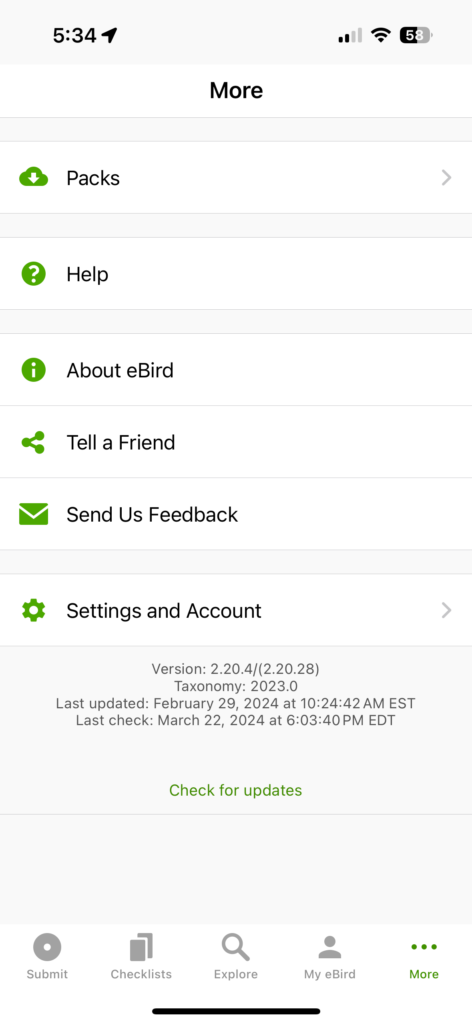

– Keep the app updated to access the latest features and improvements.

Conclusion:
The eBird app is a powerful tool for birdwatchers of all skill levels, providing a platform to record, share, and explore bird sightings around the world. By following this tutorial, you can make the most of your birding adventures and contribute to the global community of citizen scientists working to conserve avian biodiversity.
Happy birding!
By Sally Siko
Every year flocks of White crowned Sparrows move through central North Carolina during migration. Now winter is here, their populations are spread out and since they’ve settled in they’ve become a somewhat uncommon sight. Because I don’t get to enjoy these birds very often, it was fun to grab a few photos of these beauties this morning while birding at the Guilford County, Farm near Elon, NC.

With those bold stripes on their heads, White crowned Sparrows are unmistakable to ID in the field as their aptly named moniker suggests.
Measuring over 6in in length, they are larger than other sparrow species too!
You’re most likely to find them hopping across the ground and through low foliage in dense brushy habitats.
As was the case with the White crowns pictured here, they are also fond of hunting for a meal in the grassy edges of hedge lines popping out of the brush for a second or two, landing on a fence or out in the open to scope out its surroundings.




The White-crowned Sparrows will stick around central North Carolina until May, then departing for their breeding grounds across northern Canada, Alaska, California and northern New Mexico.
If you’d like to go see them for yourself this winter, I’ve included a link to their exact location at the Guilford County Farm in this post.
Photos by Sally Siko of @bestlife_birding captured on my mighty mirrorless monster, the @canonusa #R5
By Sally Siko
While birding yesterday at Ft.Fisher NC I spotted a Little Blue Heron hunting for a meal in a small pond alongside a Great Egret, a Tricolored Heron and a Snowy Egret.
It was neat to watch the four birds making their way around each other in order to catch a meal.

Interestingly this species is closely related to the Snowy Egret (same genus), a white bird of similar size.
Their similarities are especially noticeable as first-fall and first-winter immature Little Blues are completely white in plumage and are easily confused with Snowy Egrets.
The easiest way to tell the two species apart from a distance is to observe their feeding habits.
Unlike the Snowy’s who are constantly on the move, the Little blue Heron is slow and methodical in its feeding approach, walking very slowly in shallow waters or standing still waiting for prey to approach.



These beautiful birds are known to breed here in NC. Their nests are flimsy, hardly more than a few layers of loose twigs and sticks haphazardly stacked to provide a platform for the eggs to be laid.
Their typical clutch is 3-4 eggs, with an incubation period of three weeks and a nesting period of six weeks.
While in the nest, both parents feed the young by regurgitating a softened stew of prey. Within four weeks after hatching, the chicks are capable of short flights but don’t become independent until around six to seven weeks.
Little Blue Herons are a year round residents in the coastal regions of the Carolinas. Although they are typically live near saltwater areas they prefer freshwater habitats, in fact they’re also occasionally spotted inland all the way to the Triangle (central NC) from June to August.
They are usually seen hunting for fish, invertebrates, frogs, small reptiles and insects in shallow freshwater marshes, ponds and on mudflats.
What a beauty!
Photos by Sally Siko of @bestlife_birding captured on my mighty mirrorless monster, the @canonusa #R5